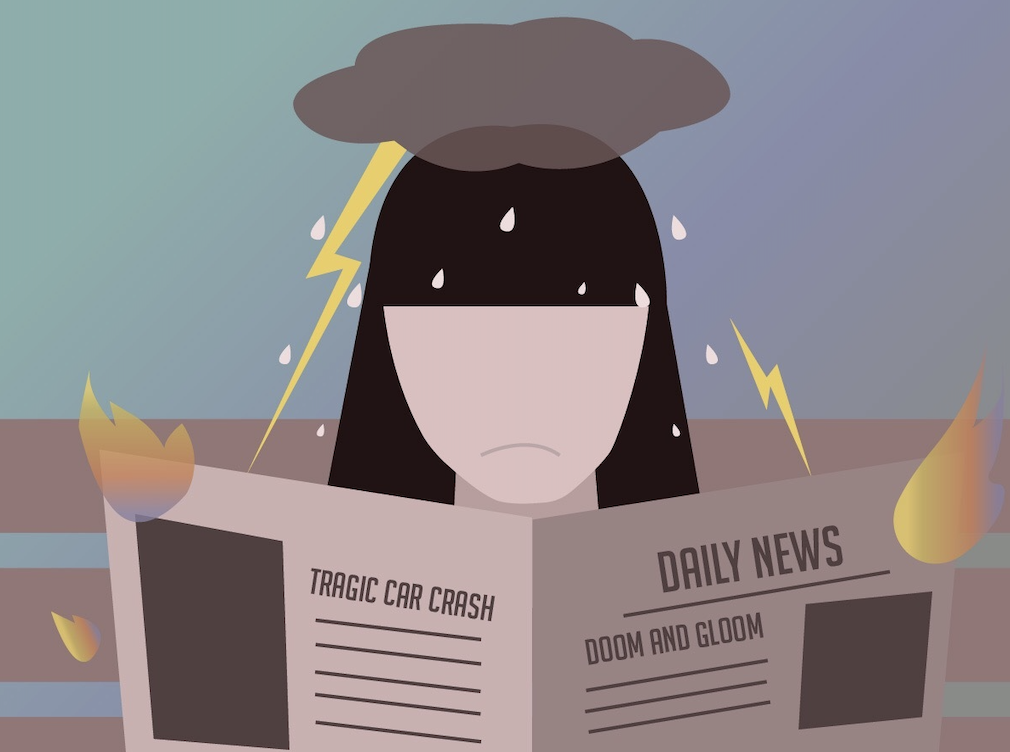Dear Rita Skeeter: Media organizations need more positive news coverage

In the “Harry Potter” series, journalist Rita Skeeter constantly tangles lies into her stories to appeal to her readers. In “Harry Potter and the Goblet of Fire,” she suggests that Harry cries at night, mourning the death of his parents; she also accuses the largely harmless Hagrid of mistreating students. In “Harry Potter and the Deathly Hallows,” she writes a book about the “disturbed childhood, the lawless youth, the lifelong feuds and the guilty secrets” of Hogwarts’ headmaster, Albus Dumbledore.
While almost all of her writing is rooted in lies, there is another throughline in her work — no matter what the subject is, she writes about it negatively. This could be attributed to her ostensible distaste for Hogwarts and the Daily Prophet’s (her wizarding newspaper employer) bias against Dumbledore and Potter, but her penchant for bad news is also rooted in something else: Negative news sells.
According to a 2014 McGill University study, subjects who were presented with a news website that contained an equal distribution of negative, positive and neutral stories were 26 percent more likely to choose a negative news story. Skeeter wasn’t only writing negatively because of her and her paper’s political motives, but also because she knew it would be appealing to her audience.
Like in the fictional world of “Harry Potter,” news organizations in the real world tend to cover mostly bad news, but not because of the readers’ cravings — bad news is often just more newsworthy.
For the most part, it makes sense that bad news is more prevalent; good news tends to exist within the “norms” of daily life. Journalists would never cover something happening as normal; they write stories when something out of the ordinary happens.
For example, the Daily Trojan would never write a story about a donor who consistently donates to the Marshall School of Business year after year. It’s great news for the University to have this source of funding, but the newspaper would cover it, at most, as part of a larger story about the University’s progress in achieving its fundraising goals. But if that donor decides to pull his donation because the University’s interim president terminated the Marshall dean they supported, it becomes newsworthy.
Furthermore, positive changes tend to happen over long periods of time, while bad news happens all at once. In any major newspaper, you’ll see daily stories about individual instances of crime, accidents, epidemics and other negative news.
And while those individual instances are important to cover, they ignore long-term, mostly positive trends occurring right now. For example, according to a 2017 FBI report, the crime rate across all violent crimes, including murder, robbery and aggravated assault, has decreased in the past 20 years by 184.7 incidents per 100,000 inhabitants, yet news organizations cover individual instances of crime just as much as they did 20 years ago and rarely report on crime reduction rates.
There’s an old axiom of journalism — “if it bleeds, it leads” — that seems to exemplify the news media’s tendency of reporting on bad news.
But beyond its mere misrepresentation of the actual state of the world, negative news imposes harmful effects on consumers. Ironically, CNN (probably one of the biggest culprits in news media to sensationalize bad news) published an article in 2018 detailing the stressful effects of bad news.
The article noted that any time consumers hear about a traumatic event, it can cause an overactive fear response, releasing stress hormones in consumers. Because of the never-ending news cycle on social media, it is hard not to be exposed to traumatic events, whether they are earthquakes in a faraway country or local murders. This constant exposure and release of stress hormones causes fatigue, and can lead to longer term symptoms like anxiety, insomnia and depression, CNN reported.
Now more than ever, news media has a moral responsibility to turn this negative tide around. Journalists must reflect their communities accurately. If they overrepresent the amount of negative news, they are directly contributing to their consumers’ moods and overall well-being.
Journalists should consider: Is the story they’re trying to tell necessary, or just a way to use a traumatic event to get clicks? Is there an important story they’re missing because it took place over a decade?
Some media organizations are taking it upon themselves to cover only positive news — websites like Upworthy and the Good News Network only publish feel-good content. It might seem like a naive way to report on the world, but both sites are designed to act as supplements to major news organizations who primarily report on bad news.
Consumers can also have an effect on what news is reported — after all, readers are more likely to click on a negative news story than a positive one, which leads to news organizations’ increasing coverage of negative stories. News consumers should take the time to read feel-good stories and avoid negative stories that aren’t relevant to them — it’s not only good for the overall state of news, but it’s beneficial to the audience’s mental health.
Of course, bad news isn’t something news media can completely ignore — it’s often the most important news. But both consumers and journalists should reconsider their priorities in newsgathering and news consumption.
Karan Nevatia is a sophomore writing about media ethics and literacy. He is also an associate managing editor of the Daily Trojan. His column, “Dear Rita Skeeter,” runs every other Thursday.

